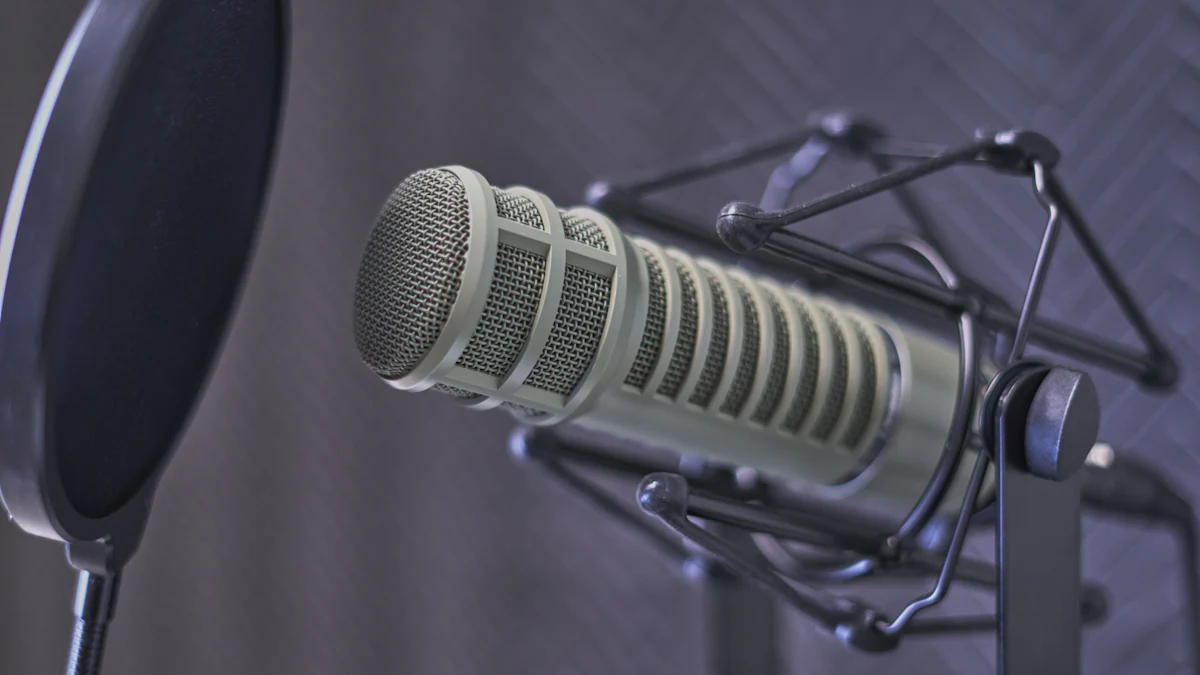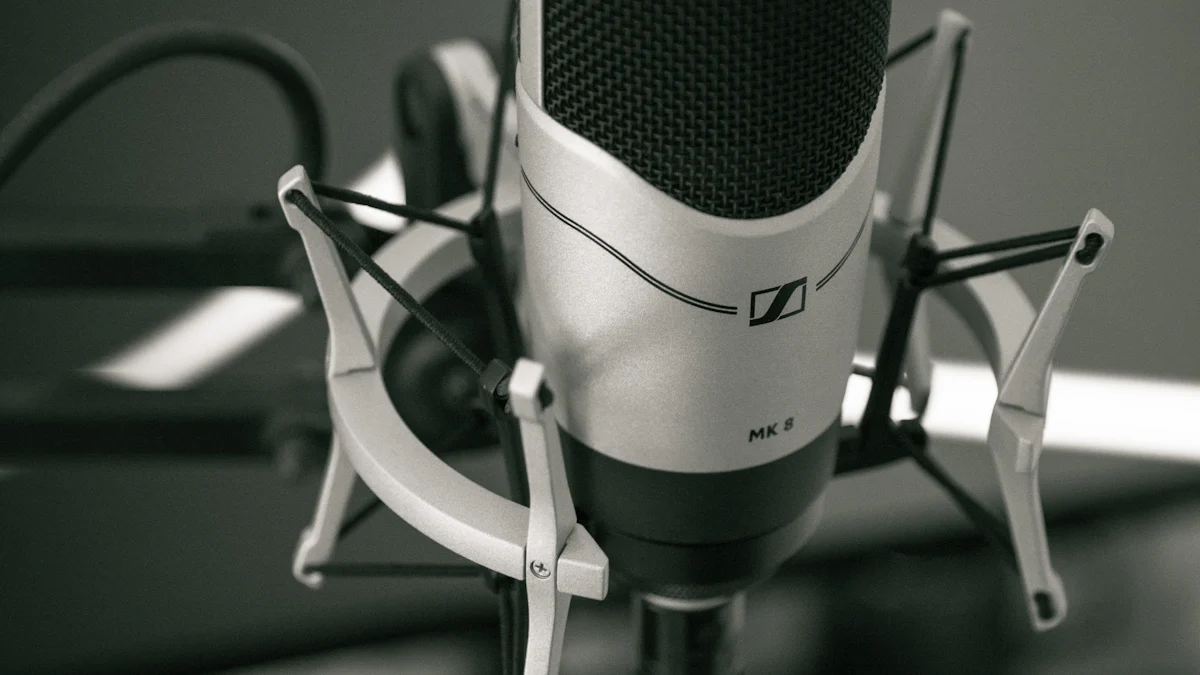A Guide to How Noise-Cancelling Mics Work in Headsets

You might wonder how noise-cancelling mics in headsets work. These devices use microphones to detect ambient sounds and generate sound waves that cancel out the noise. This technology is crucial for enhancing audio quality in various environments. The demand for noise-cancelling headphones is on the rise, driven by the increasing need for effective noise cancellation in music listening, gaming, and travel. The market for these headphones is projected to grow significantly, reaching a valuation of USD 6.36 billion by 2032. Whether you're working from home or in a bustling office, a noise-cancelling mic for headsets designed for office and home calls can make a world of difference.
How Noise-Cancelling Headphones Work

Understanding how noise-cancelling headphones work can enhance your appreciation for this technology. These devices use advanced techniques to minimize unwanted sounds, providing a clearer audio experience.
Noise Cancelling Technology
The Role of Microphones
Microphones play a crucial role in noise-cancelling headphones. They detect ambient sounds around you. By capturing these noises, the headphones can analyze the sound patterns. This analysis allows the headphones to create an opposite sound wave, effectively canceling out the unwanted noise. You benefit from a quieter environment, whether you're in a busy office or on a noisy street.
Sound Wave Inversion Process
The sound wave inversion process is at the heart of how noise-cancelling headphones work. Once the microphones pick up the ambient noise, the headphones generate a sound wave that is the exact opposite of the detected noise. This process, known as destructive interference, neutralizes the unwanted sounds. As a result, you hear only the desired audio, such as music or a phone call, without the background noise.
The Science of Noise Cancelling
Sound Waves and Interference
Sound waves travel through the air, and when two waves meet, they can interfere with each other. Noise-cancelling headphones take advantage of this principle. By producing sound waves that are 180 degrees out of phase with the ambient noise, the headphones effectively cancel out the noise. This interference reduces the overall sound level, allowing you to focus on what you want to hear.
Technology in Headsets
The technology in noise-cancelling headsets has evolved significantly. Modern headsets use sophisticated algorithms to process the sound data collected by the microphones. These algorithms ensure that the sound cancelling headphones work efficiently in various environments. Whether you're using them for gaming, music, or calls, the technology adapts to provide optimal noise reduction. This adaptability makes noise-cancelling headphones a valuable tool for enhancing your audio experience.
Types of Noise-Cancelling

When exploring noise-cancelling technology, you will encounter two main types: active noise cancelling and passive noise cancelling. Each type offers unique benefits and uses different methods to reduce unwanted sound.
Active Noise Cancelling
Active noise cancelling (ANC) technology uses advanced techniques to eliminate unwanted noise. This method involves microphones and electronic circuitry to counteract ambient sounds.
How Active Noise Cancelling Works
Active noise cancelling works by using built-in microphones to detect external noise. The headphones then generate a sound wave that is the exact opposite of the detected noise. This process, known as destructive interference, effectively cancels out the unwanted sound. You experience a quieter environment, allowing you to focus on your music or calls without distraction.
Examples in Headsets
Many modern headsets incorporate active noise cancelling technology. Brands like Bose, Sony, and Soundcore offer models with ANC features. These headphones are ideal for environments with constant background noise, such as airplanes or noisy environments. By choosing headsets with active noise cancelling, you can enjoy an immersive audio experience.
Passive Noise Cancelling
Passive noise cancelling relies on the physical design of the headphones to block out sound. This method does not use electronic components but instead focuses on materials and fit.
Materials and Design
Passive noise cancelling headphones use materials like dense foam and snug ear cups to create a seal around your ears. This seal helps to block out external noise by physically preventing sound waves from reaching your ears. The design and composition of these headphones play a crucial role in their effectiveness.
Comparison with Active Noise Cancelling
While both active and passive noise cancelling aim to reduce unwanted sound, they do so in different ways. Active noise cancelling uses technology to eliminate noise, while passive noise cancelling relies on materials and design. Passive noise isolation often works alongside ANC to enhance the overall noise reduction. In some cases, hybrid active noise cancelling combines both methods for optimal performance. When choosing between the two, consider your environment and personal preferences.
By understanding the differences between active and passive noise cancelling, you can make an informed decision about which type of headphones best suits your needs. Whether you prefer the technological approach of active noise cancelling or the simplicity of passive noise cancelling, both options offer valuable benefits for enhancing your audio experience.
Benefits of Noise-Cancelling Mics
Noise-cancelling mics offer numerous benefits that enhance your audio experience and contribute to your well-being. By understanding these advantages, you can make informed decisions about using noise-cancelling technology in your daily life.
Enhanced Audio Experience
Improved Sound Quality
Noise-cancelling mics significantly improve sound quality. By reducing unwanted background noise, these mics allow you to hear audio more clearly. Whether you're listening to music or participating in a call, the clarity of sound enhances your overall experience. You can enjoy every note and word without the distraction of ambient sounds. This improvement is especially beneficial when using a noise-cancelling mic for headsets designed for office and home calls, where clear communication is crucial.
Better Focus and Concentration
Noise-cancelling mics help you focus better by minimizing distractions. In environments with constant noise, such as busy offices or homes, maintaining concentration can be challenging. By creating a quieter auditory environment, these mics enable you to concentrate on tasks more effectively. This benefit extends to individuals with tinnitus, as the reduction of background noise can make the condition less intrusive. As a result, you can work or study with greater efficiency and less stress.
Health and Safety Benefits
Reduced Ear Strain
Using noise-cancelling mics can reduce ear strain. Constant exposure to loud noises can lead to discomfort and fatigue. By blocking out these sounds, noise-cancelling technology allows you to listen at lower volumes. This reduction in volume decreases the risk of ear strain and potential hearing damage. You can enjoy your audio content comfortably and safely, whether you're using headphones for leisure or professional purposes.
Protection from Loud Environments
Noise-cancelling mics provide protection from loud environments. In places with high noise levels, such as construction sites or crowded public spaces, these mics help shield your ears from harmful sounds. By creating a barrier against excessive noise, they contribute to your auditory health. This protection is particularly valuable when using a noise-cancelling mic for headsets designed for office and home calls, ensuring that you can communicate effectively without compromising your hearing.
Common Concerns and FAQs
When considering noise-cancelling technology, you might have questions about its effectiveness and safety. This section addresses common concerns and provides valuable insights.
Effectiveness of Noise-Cancelling Technology
Best Situations for Use
Noise-cancelling headphones excel in environments with constant background noise. You will find them particularly useful in places like airplanes, busy offices, or public transportation. These headphones create a quieter space, allowing you to focus on your audio content without distractions. Whether you're listening to music, participating in a call, or simply enjoying some peace, noise-cancelling technology enhances your experience.
Limitations of Noise-Cancelling Mics
While noise-cancelling mics offer significant benefits, they do have limitations. They work best with consistent, low-frequency sounds, such as engine noise or air conditioning hum. Sudden or irregular noises, like people talking or doors slamming, may not be completely canceled. Additionally, some users, especially those with tinnitus, might find that reducing ambient noise can sometimes exacerbate their symptoms. It's essential to consider these factors when choosing noise-cancelling headphones.
Safety of Noise-Cancelling Headsets
Potential Health Concerns
You might wonder if noise-cancelling headsets pose any health risks. Generally, these headphones are safe to use. They can even protect your hearing by allowing you to listen at lower volumes. However, prolonged use at high volumes can still lead to hearing damage. It's crucial to maintain a moderate volume level to ensure your auditory health.
Myths and Facts
Several myths surround noise-cancelling technology. Some believe that these headphones emit harmful radiation, but this is not true. Noise-cancelling headphones, including Bluetooth noise cancelling headphones, use safe technology. Another common myth is that they completely eliminate all noise. In reality, they significantly reduce unwanted sounds but may not cancel every noise. Understanding these facts helps you make informed decisions about using wireless noise cancelling headphones.
Noise-cancelling technology in headphones offers numerous benefits. By using microphones to detect ambient sounds and generating counteracting sound waves, these headphones create a quieter listening environment. This enhances audio immersion and clarity, allowing you to enjoy music or calls without distractions. Noise-cancelling headphones also protect your ears from harmful noises, reducing the risk of hearing damage. They improve focus and productivity by minimizing background noise, making them ideal for work or study. Consider investing in noise-cancelling headphones to experience these advantages and elevate your audio experience.
See Also
A Comprehensive Guide to Enhancing Audio Visual Skills
Everything You Need to Know About 360-Degree Video Cameras
Step-by-Step Instructions for 360-Degree Video Projectors
